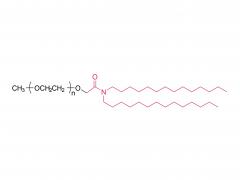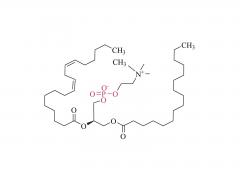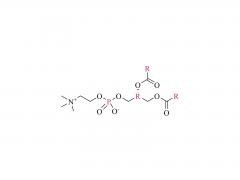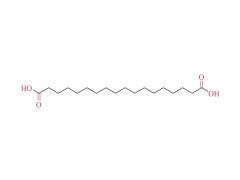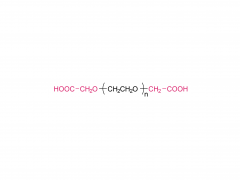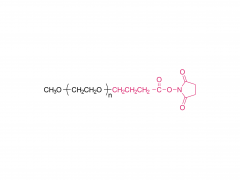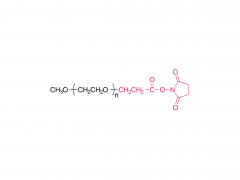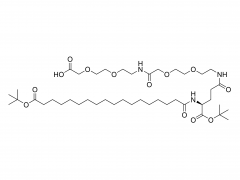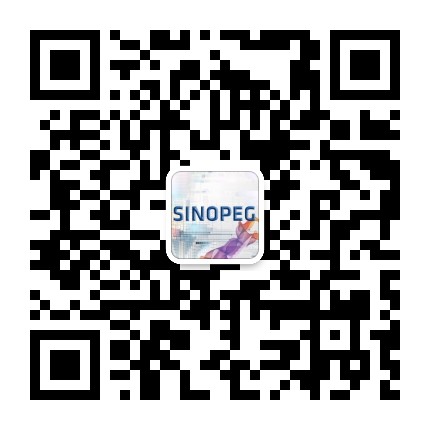
mPEG-SG, or methoxypolyethylene glycol succinimide glutarate, is an important polymer compound whose ester bond in its structure connects the two parts of methoxypolyethylene glycol (mPEG) and succinimide glutarate (SG), giving it unique properties and a wide range of applications.
1. Structural characteristics
Methoxy-polyethylene glycol (mPEG) parts:
mPEG is a form of polyethylene glycol (PEG) whose ends are modified by methoxy (–OCH₃).
It gives mPEG-SG good water solubility and biocompatibility, allowing it to remain stable in the body for a long time and reduce interaction with the immune system.
Succinimide glutaric acid (SG) part:
The SG section introduces an active group, the succinimide group (also known as the NHS ester group).
This group has the ability to react with amino groups in biological macromolecules (such as proteins, peptides, etc.) to form stable amide bonds.
Ester bond:
The key chemical bond that connects mPEG and SG.
Under certain environmental conditions (such as hydrolysis or enzymatic catalysis), the ester bond may break, thereby releasing the active substance. In drug delivery systems, this property is often used to control drug release rates.
2. Application field
Biomedical Science:
Due to its good biocompatibility and water solubility, mPEG-SG is often used in the preparation and modification of biological materials, as well as in the research of drug delivery systems.
It can be used for the labeling and tracking of biomolecules to study the functions and interactions of biomolecules.
Materials Science:
As a modified material, improve the performance and application range of the material.
It can be used to prepare functional polymer materials and nanomaterials to improve the hydrophilicity and stability of materials.
Drug delivery systems:
As a drug carrier or modifier, it helps to improve the solubility and stability of drugs and improve the bioavailability of drugs.
By controlling the breaking rate of ester bond, the slow release effect of the drug was realized.
Nanotechnology:
It also shows great application potential in the field of nanotechnology, which can be used to prepare nanoparticles and nanocomposites.
Product technical advantage
SINOPEG offers high quality PEG derivatives with novel and diverse product structures, abundant substituting groups, and high end-group substitution rates.
High PEG functional group content - Content up to 99%
Functionalization of PEG is the most difficult of PEG products. The common problem of the main products on the market is that the functional group content is not high. And we master the modification technology, initiation system, unconventional precipitation method and system extraction method and other technologies and processes can easily produce high functional group content products. The functional group content of most products can reach 99%, which is much higher than the 90% or so of rivals.
High quality PEG molecular weight control -PDI <1.05
The single molecule chain of a polymer is usually composed of many small repeating units connected by polymerization. The design and control of the synthesis method has a crucial influence on the length of a single polymer segment and the similarity of the length of multiple polymer segments. Our PEG synthesis technology guarantees very good dispersion (PDI<1.05), while many other companies' products typically have PDI around 1.1.
Relevant recommendation
|
mPEG-NH2
|
3-arm PEG-OH
|
|
mPEG-CM
|
3-arm PEG-NH2
|
|
mPEG-SA
|
3-arm PEG-CM
|
|
mPEG-SH
|
3-arm PEG-SH
|
|
mPEG-pALD
|
3-arm PEG-SC
|
|
mPEG-MAL
|
3-arm PEG-N3
|
|
mPEG-SC
|
3-arm PEG-NH2·HCl
|
|
mPEG-NPC
|
4-arm PEG-OH
|
|
mPEG-SS
|
4-arm PEG-NH2
|
|
mPEG-N3
|
4-arm PEG-CM
|
|
mPEG-AA
|
4-arm PEG-SA
|
|
mPEG-MA
|
4-arm PEG-SH
|
|
mPEG-VS
|
6-arm PEG-OH
|
|
mPEG-NH2·HCl
|
6-arm PEG-NH2
|
|
2-arm PEG-OH
|
6-arm PEG-CM
|
|
2-arm PEG-COOH
|
6-arm PEG-SA
|
|
2-arm PEG-NHS
|
6-arm PEG-SH
|
|
2-arm PEG-MAL
|
8-arm PEG-NH2
|
|
2-arm PEG-NH2
|
8-arm PEG-CM
|
|
2-arm PEG-Acetal
|
8-arm PEG-SA
|
|
2-arm PEG-CHO
|
8-arm PEG-SH
|
|
2-arm PEG-N3
|
8-arm PEG-pALD
|







